We want to not only give you a great look at the Yosemite National Park free camping spots but everything that is available to you in the park. We give you the best places to visit, things to do, packing lists and hiking options.
There are many reasons to make you visit Yosemite National Park. First of all, this park is one of the formidable natural landscapes in California US which is roughly 1200 square miles. The park has a lot of stunning features that you can enjoy anytime you go there. There are plenty of towering waterfalls, cliff faces, unique rock formations, millennia-old Sequoia trees, wildlife, lakes, and glaciers that are just fascinating for you to see.
Want more ideas to round-out your trip to California?
A lot of great ideas are in these posts!
- 18 Free Devils Postpile National Monument Boondocking Locations
- 15 Great Berryessa Snow Mountain National Monument Boondocking Locations
- 20 Free Sequoia National Park RV & Camping Locations
- 14 Castle Mountains National Monument Boondocking Locations
- 23 Best Boondocking Spots Near Death Valley National Park
- 27 Top Joshua Tree National Park Boondocking Spots
- 14 Free Sequoia National Monument Boondocking Locations
- 15 Great Lake Tahoe Boondocking Locations (Updated 2022)
However, most of the activities that you do in the park are within Yosemite Valley which is only 8-square miles. In this valley, you will find famous landmarks such as El Capitan and Half Dome and excellent hiking trails which make your trip worth it. You can find fun through hiking, rock climbing, skiing, horse riding, and many more activities. These are enough reasons for you to explore the park and be among the 4 million visitors annually.
The park can be expensive so we suggest you take a look at all of the Yosemite National Park free camping spots in our post. You will find that these Yosemite National Park free camping spots are located all around the park and it is much cheaper to stay outside and drive 10 to 15 miles than paying the park fees.
History of Yosemite National Park
Yosemite National Park was created on October 1, 1890, by an act of congress and it is home to many natural wonders like the Half Dome and the sequoia trees. The residents of Yosemite Valley were Native Americans until 1849 when the gold rush brought many non-American miners to the region. In 1864, President Abraham Lincoln declared Yosemite Valley a public trust of California to protect it from further damage and exploitation by the settlers who occupied the valley due to the gold rush.
There are many black and white Yosemite’s photographs which were taken by Ansel Adams (1902 -1984). Adams lived in the park for many years just to take the park’s photographs. Today many visitors stream into this park to check out landmarks such as the Yosemite Falls as well as the El Capitan and Half Dome rock formations.
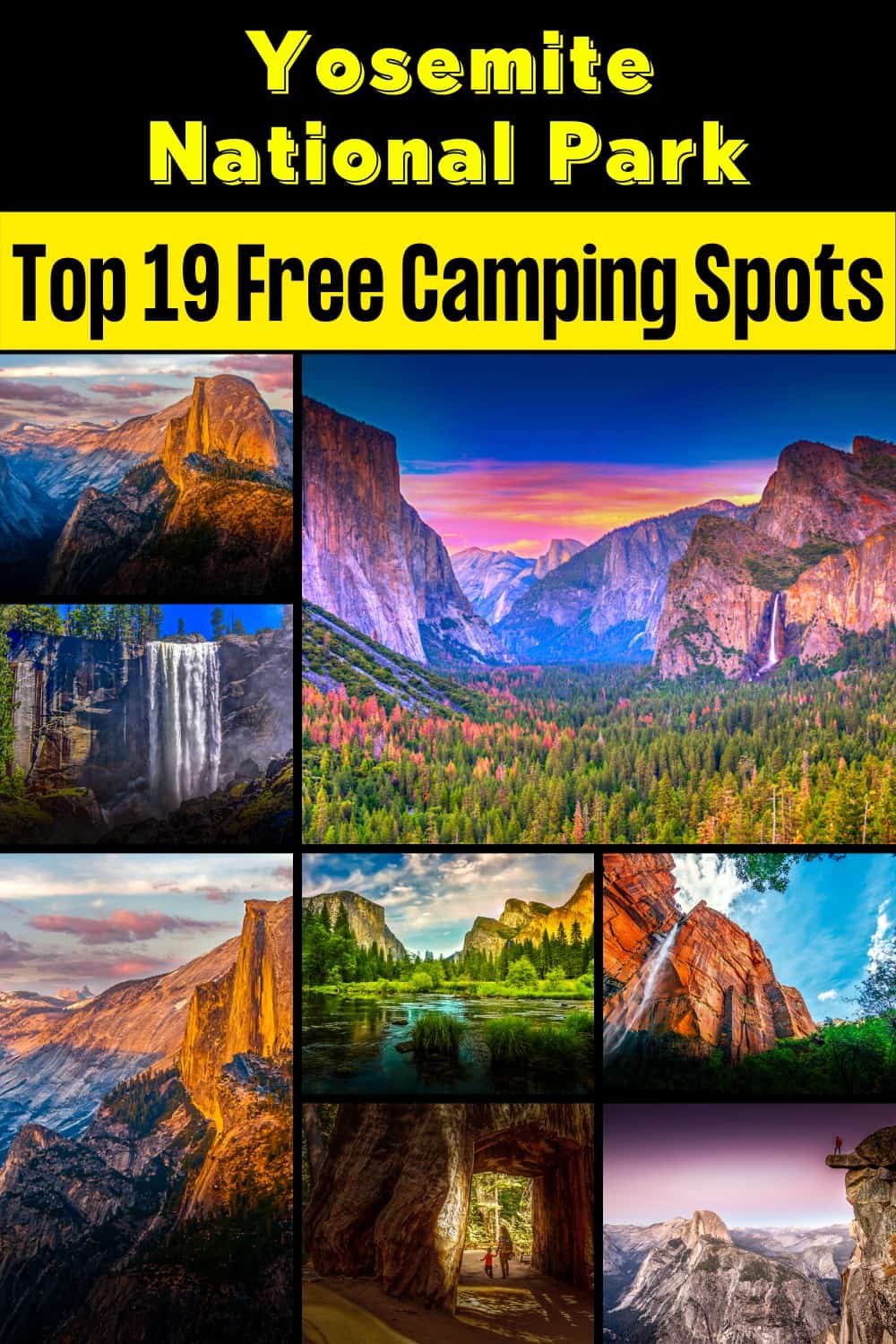
15 Top Yosemite National Park Boondocking Spots
check out our video
1. Yosemite National Park Boondocking Locations – Warren Fork Trail Head
Address
Tioga Road
Lee Vining, California
GPS: 37.953181, -119.226883
Elevation: 9049′
Management: National Forest Service
Free Dispersed camping in the Inyo National Forest’s Mono Lake Ranger District. This Yosemite National Park boondocking spot does not use a reservation system. First come, first served. This is a high elevation location. Free Dispersed camping in the Inyo National Forest’s Mono Lake Ranger District. This campsite does not use a reservation system. First come, first served. This is a high elevation location.
Best Review:
None
2. Yosemite National Park Free Camping Spots – Bloody Canyon Trailhead Campground
Address
June Lake Loop
June Lake, California
GPS: 37.872517, -119.158775
Elevation: 8351′
Management: National Forest Service
There are 1-5 campsites at this location. You may stay 14 days at the Yosemite National Park boondocking spot for the Bloody Canyon Trailhead Campground. On Forest Road 1S23 Near Mono Lake and US highway 395 – South of Yosemite – North of Mammoth Lakes. Leave Highway 395 at the north end of the June Lake Loop, Hwy 158. Just North of Grant Lake, follow dirt road1S23 along Sawmill Creek to the Trailhead.
Best Review:
None
3. Yosemite National Park Boondocking Spots – Bloody Canyon Rd
Address
Sawmill Canyon Road
Lee Vining, California
GPS: 37.874087, -119.1473
Elevation: 7808′
Management: National Forest Service
This Yosemite National Park boondocking spot at Bloody Canyon is open Jun-Oct. This free campsite is located within the Inyo National Forest’s Mono Lake Ranger District. This is a high elevation location.
Best Review:
None
4. Yosemite National Park Boondocking Locations – Virginia Creek Camping
Address
Lee Vining, California
GPS: 38.057125, -119.241878
Elevation: 9412′
Management: National Forest Service
Free Dispersed Camping-> No Reservations
Best Review:
You may stay 14 Days at Virginia Creek Camping Area for the Yosemite National Park boondocking visitors. Great place to camp. They have outhouses. The actual campground closer to the trailhead is $18 per night (concession forest campground). This spot was way better and right on the creek. Very quiet when we were there. Clean campground as well.
5. Yosemite National Park Free RV Parking – Virginia Lakes Road
Address
Lee Vining, California
GPS: 38.063738, -119.227238
Management: National Forest Service
The road into this Yosemite National Park boondocking spot is Gravel and 2.3 miles from a paved road. There are 1-5 campsites at this location and the maximum RV length is 25 feet. This site is on a gravel forest road off Virginia Lakes Road.
Best Review:
From route 395 it is 2.3 miles on your left. Suitable for smaller class c’s (ours is 25 but we managed to get in) and other smaller vehicles (in width and length). There are approx 3 – 5 possible sites in here and they are streamside.
6. Yosemite National Park Boondocking Spots – Harden Flat Road Dispersed
Address
31605 Hardin Flat Road
Groveland, California
GPS: 37.813243, -119.93447
Elevation: 3570′
Management: National Forest Service
Free Dispersed camping in the Stanislaus National Forest’s Groveland Ranger District. First come -> First Camped. Reservations not accepted at this Yosemite National Park boondocking spot.
Best Review:
Stayed here 2 nights on a 3 day Yosemite trip. The aforementioned rocks are no longer blocking as I could tell. I turned down golden arrow road and went right and there were a few campsites.
7. Yosemite National Park Boondocking Locations – Mono Lake Basin Boondock
Address
Picnic Grounds Road
Lee Vining, California
GPS: 37.944889, -119.093529
Elevation: 6732′
Management: State Park
There are 1-5 campsites at this location. Dispersed camping is permitted in most of the Scenic Area above the exposed lake bed lands. Campfire permits are required. Camping around Mono Lake and its shore is allowed but you must select a site that is above the 1941 shoreline (roughly where the brushy vegetation begin).
Best Review:
Site Closed
8. Yosemite National Park Free Camping Spots – Green Creek Road
Address
Lee Vining, California
GPS: 38.12017, -119.24934
Elevation: 7858′
Management: National Forest Service
Many campsites all the way up Green Creek Road. Great Yosemite National Park boondocking spot.
Best Review:
9. Yosemite National Park Boondocking Spots – Iron Lakes
Address
6S10
Bass Lake, California
GPS: 37.489747, -119.501977
Elevation: 8478′
Management: National Forest Service
Free Dispersed camping in the Sierra National Forest’s Bass Lake Ranger District. This Yosemite National Park boondocking spotdoes not use a reservation system. First come, first served. This is a high elevation location.
Best Review:
This is a high clearance 4X4 area. Not suitable for motorhome or trailers.
Four stars for the scenery. Vehicle used to access the area was 4X4 vehicle.
10. Yosemite National Park Free RV Parking – Eagles Meadows
Address
Bridgeport, California
GPS: 38.18159, -119.408718
Elevation: 11593′
Management: National Forest Service
The road in is Dirt. Eagles Meadows is open summer. There are 16-29 campsites at this location and the maximum RV length is unlimited. You may stay 14 Days at eagles meadows. Secluded with no amenities.
Best Review:
None
11. Yosemite National Park Free Camping Spots – Goat Meadow Trailhead and Snow Play Area
Address
Fish Camp, California
GPS: 37.491268, -119.623491
Elevation: 5285′
Management: National Forest Service
Parking lot available for Yosemite National Park boondocking 1/2 mile from Yosemite Gate. Turn onto Mt Raymond Road which is about a mile past Summerdale Campground.
Best Review:
None
12. Yosemite National Park Boondocking Spots – Summit Camp
Address
7214 Chowchilla Mountain Road
Fish Camp, California
GPS: 37.508785, -119.694757
Elevation: 5541′
Management: National Forest Service
Summit Camp is open Jun-Oct.
Best Review:
This Yosemite National Park boondocking spot was beautiful, it was amazing to camp among sequoia trees! There was only one other campsite that was used while we were there on a Saturday night in July. We were in a tent and there were multiple spots to pick from. There are no bathrooms and you have to have a permit to have a fire.
13. Yosemite National Park Boondocking Locations – FS 5s09
Address
Fish Camp, California
GPS: 37.499083, -119.670139
Management: National Forest Service
Free Dispersed Camping-> No Reservations
Best Review:
A campsite in the National Forest just outside the South entrance of Yosemite National Park. Very quiet. Easy 1 lane road.
14. Yosemite National Park Free Camping Spots – Granite Creek Campground
Address
California
GPS: 37.538208, -119.264557
Elevation: 6972′
Management: National Forest Service
The road into this Yosemite National Park boondocking spot is Dirt. The maximum RV length at Granite Creek Campground is 20 feet. Located along Granite Creek, Granite Creek Campground has two loops containing 20 campsites.
Amenities:
Fire Ring
Horse Corral
Near Water
Pets Welcome
Picnic Tables
Restrooms
Best Review:
Fir trees provide a good amount of shade at campsites. Horses are not permitted in the lower loop; however, the upper loop of the facility is horse-friendly and offers corrals.
15. Yosemite National Park Free RV Parking – Summit Rd Dispersed
Address
Fish Camp, California
GPS: 37.47922, -119.65925
Elevation: 5719′
Management: National Forest Service
Dispersed spots along Summit Rd just before Fish Camp. A couple of spots few and far between but it’s close to the park entrance.
Best Review:
There was a gate blocking us from entering the area so we could not go in sadly… maybe it was because I visited in the off-season (late October)?
Top Trails to Hike at the Yosemite National Park
Yosemite National Park has 116 hard trails that range between 3.4 and 339.6 kilometers. The height above sea level of these trails is from 1167 to 4412 meters. In the USA, Yosemite is one of the parks with very beautiful hikes and landscapes. These trails lead you to some fascinating sceneries such as the Tuolumne Meadows. Below are the main Yosemite National Park trails:
1. Vernal & Nevada Falls through the Mist Trail
This is a loop trail that is 14.2 kilometers and heavily trafficked. It is located close to the Yosemite Valley and by hiking on it you gain an elevation of 668 meters hence it is rated as difficult. The trail features a waterfall and is best used between May and October for activities such as hiking and fascinating views.
Length: 6.0 mi
Elevation gain: 2,162 ft
Route type: Loop
Hiking, Forest, Partially paved, River, Views, Waterfall, Wildflowers, Wildlife, Rocky, Fee, No dogs

2. Glacier Point Trail
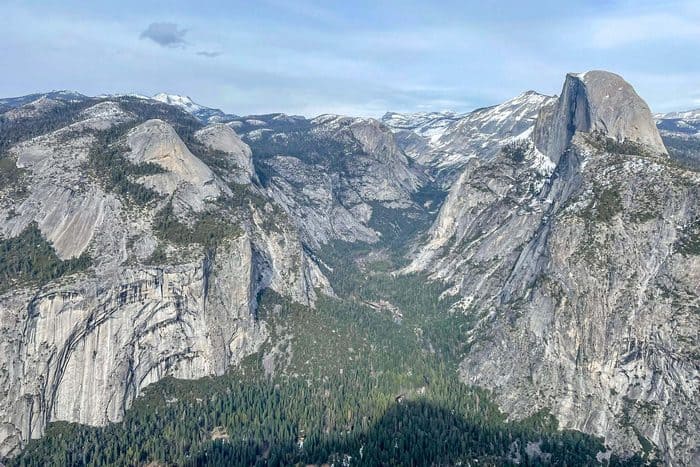
Glacier Point Trail is just one kilometer long with an elevation gain of 51 meters only hence rated as easy and can be used by people of all ages and skill levels. It is best used between May and October mainly for hiking, snowshoeing, and nature trips.
Length: 0.6 mi
Elevation gain: 167 ft
Route type: Loop
Wheelchair friendly, Kid friendly, Stroller friendly, Hiking, Walking, Forest, Paved, Views, Waterfall, Wildflowers, Wildlife, Fee, No dogs

3. Lower Yosemite Falls Trail
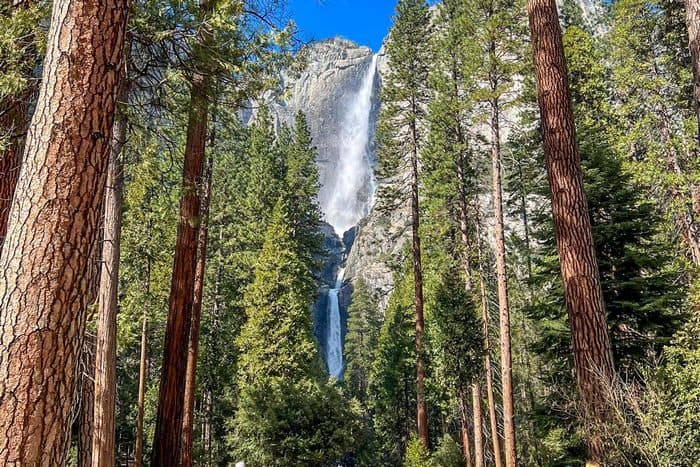
Lower Yosemite Falls Trail is a loop trail that is heavily trafficked and 1.9 kilometers in length with an elevation gain of 18 meters only. This means that it is very easy to hike through this trail and anybody regardless of age or skills can do it. It is located near Yosemite Valley and it features a lake. The trail is accessible throughout the year and is mainly used for walking. It only takes 28 minutes to do this trail.
Length: 1.2 mi
Elevation gain: 59 ft
Route type: Loop
Dogs on leash, Wheelchair friendly, Kid friendly, Stroller friendly, Hiking, Walking, Forest, Lake, Paved, River, Views, Waterfall, Wildlife, Fee

4. Half Dome via Little Yosemite Valley Campsite
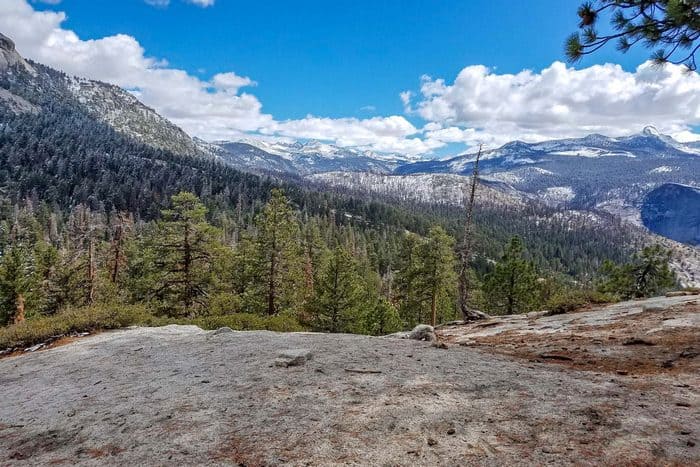
Half Dome Trail is a back trail that is heavily trafficked and has a length of 28 kilometers with an elevation gain of 1802 meters. The difficulty level of hiking through this trail is therefore rated as hard. The trail is located near Fish Camp and it features a waterfall. Half Dome Trail is mainly used for rock climbing and hiking, and it is recommended mainly for experienced adventurers. It takes you an estimated time of 11 hours round trip.
Length: 6.8 mi
Elevation gain: 2,719 ft
Route type: Out & back
Backpacking, Camping, Hiking, Rock climbing, Views, Fee, No dogs

5. Upper Yosemite Falls Trail
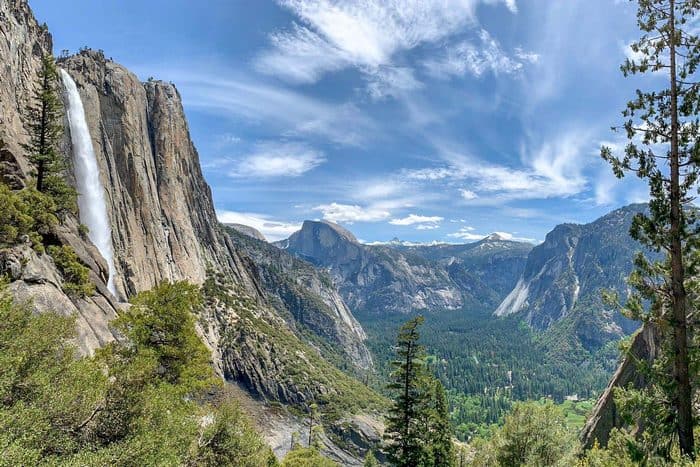
Upper Yosemite Falls Trail is a back trail that is 12.2 kilometers in length with an elevation gain of 985 meters and hence it is also rated as difficult. The trail features a waterfall and is mainly used for hiking. It takes you approximately 4 hours and 30 minutes round trip but it is recommended only for experienced adventurers.
Length: 7.6 mi
Elevation gain: 3,218 ft
Route type: Out & back
Backpacking, Camping, Hiking, Forest, River, Views, Waterfall, Wildflowers, Wildlife, Rocky, Fee, No dogs

6. Vernal Falls
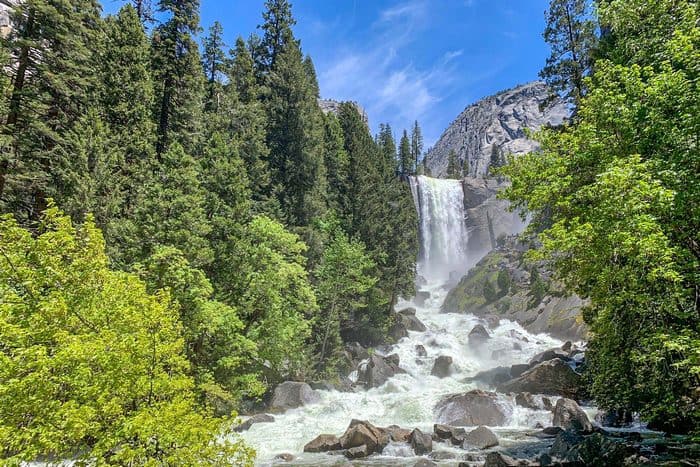
Vernal Falls is a back trail that has a length of 6.4 kilometers and an elevation gain of 390 meters. The difficulty level of Vernal Falls Trail is hence rated as moderate. This trail is located near Yosemite Valley and it features a waterfall. The trail is best used between May and November primarily for hiking, nature trips, and walking.
Length: 4.0 mi
Elevation gain: 1,279 ft
Route type: Out & back
Hiking, Forest, Partially paved, River, Views, Waterfall, Wildflowers, Wildlife, Fee, No dogs

7. Four Mile Trail
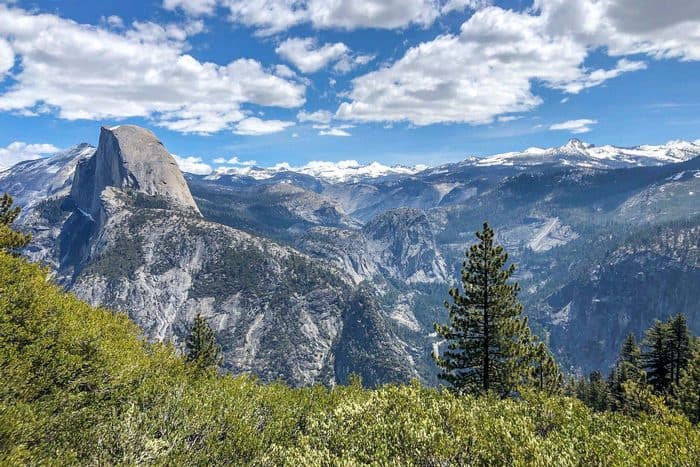
Four Mile is a back trail where you cover a distance of 14.8 kilometers in approximately 6 hours and gain an elevation of 1101 meters. Thus the trail is rated as hard and only experienced adventurers are recommended. Four Mile Trail is located near Yosemite Valley and it features a waterfall. It is best used between April and November mainly for hiking and running.
Length: 9.2 mi
Elevation gain: 3,612 ft
Route type: Out & back
Hiking, Forest, River, Views, Waterfall, Wildflowers, Wildlife, Fee, No dogs

8. Sentinel Dome Trail
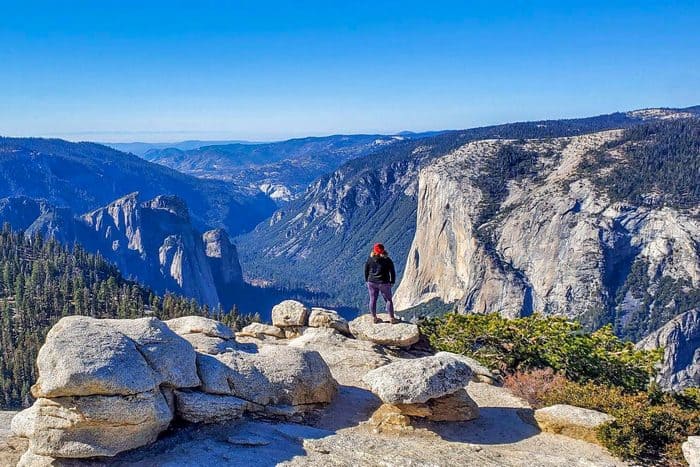
Sentinel Dome Trail is 3.4 kilometers with an elevation gain of 139 meters hence rated as easy and anybody can use it. It features beautiful wildflowers and is best used between April and November mainly for hiking.
Length: 2.1 mi
Elevation gain: 456 ft
Route type: Out & back
Hiking, Forest, Views, Wildflowers, Wildlife, Fee, No dogs

9. Clouds Rest Trail
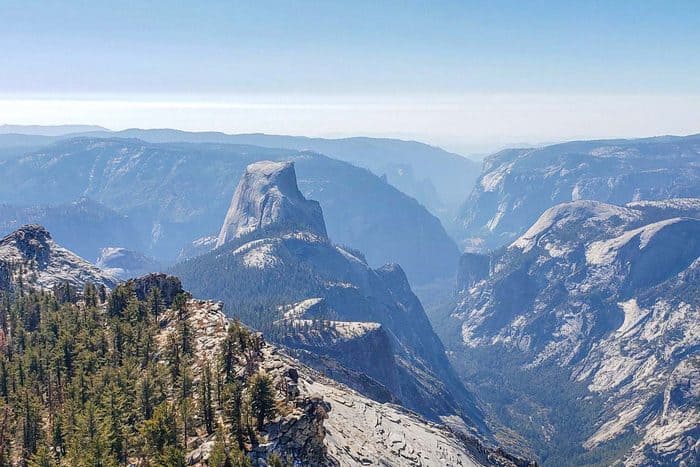
Clouds Rest Trail is 20.9 kilometers with an elevation gain of 949 meters hence it is rated as difficult. It is located near Yosemite Valley and features beautiful wildflowers. It is best used between March and October mainly for hiking, backpacking, and camping.
Length: 14.0 mi
Elevation gain: 3,166 ft
Route type: Out & back
Backpacking, Camping, Hiking, Forest, Lake, Views, Wildflowers, Wildlife, Rocky, Scramble, Fee, No dogs

10. Vernal Falls & Clark Point through Mist & John Muir Loop
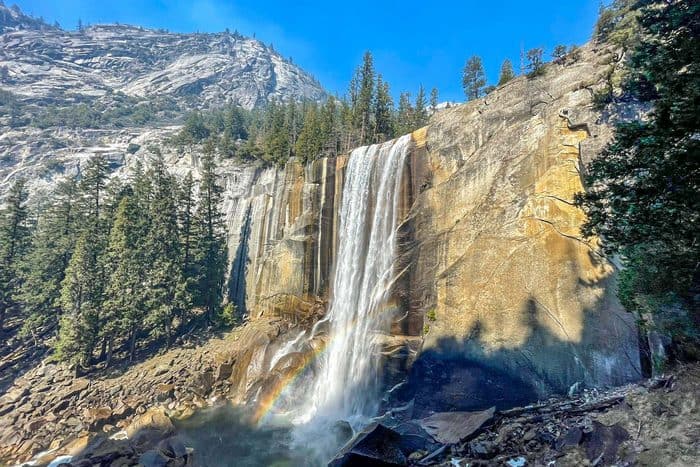
This trail is 6.8 kilometers with an elevation gain of 473 meters hence rated as difficult. It features a waterfall and is mainly used for hiking from April to October.
Length: 4.2 mi
Elevation gain: 1,551 ft
Route type: Loop
Hiking, Partially paved, River, Views, Waterfall, Wildlife, Rocky, Fee, No dogs

How to Get To the Yosemite National Park
Yosemite National Park is one of the most convenient parks to visit in the USA. This is because it is surrounded by a variety of airports and the distance between the airports and the park is a driving distance that does not take much time. Fresno-Yosemite International Airport is the closest to the park and from this airport; you will have to drive for a distance of 65 miles in about 1 hour and 30 minutes to reach the park.
The other airports close to Yosemite National Park are San Francisco International Airport, San Jose International Airport, and Oakland International Airport. From these airports, you will need to drive roughly 3 hours to reach the park. To get around Yosemite National Park, a car is the best option compared to Yosemite’s shuttles. However, during the summer season when the park is crowded, Yosemite’s shuttles become a better alternative due to huge road traffic and parking lots filling up so fast.
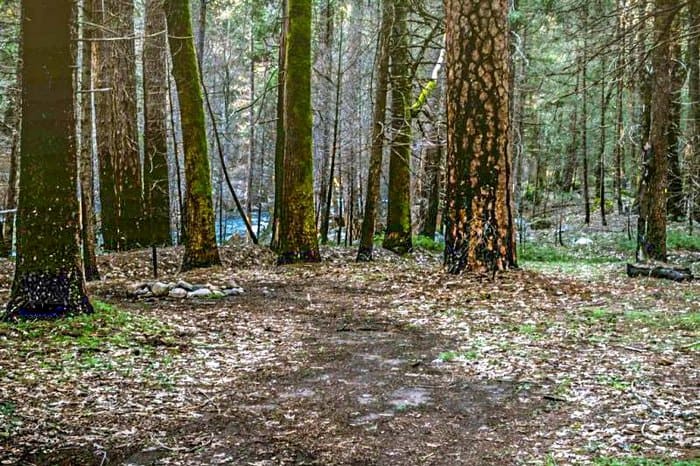
Choosing the Right Entrances to Yosemite National Park
Are you planning to take your friends or family to Yosemite National Park? Well, this is an excellent park you can visit over the weekend or during the holidays since it has a lot to offer. One thing to note, though, is that Yosemite National Park has a total of five entrances you can use to access the park. So, which is the best Entrance to use?
Well, if you are wondering where to pass to access the park, this is the right article to read as we are going to review the five entrances to Yosemite National Park and what to expect on your way. From our reviews, choose based on where you come from and the experience you want to have at the park.
1. Hetchy Entrance
This is the Entrance that you access when you come from highway 120 and by Evergreen road. I would highly recommend this Entrance to people who don’t want much commotion or tagging kids along. It is a much quieter entrance, has lesser crowds, and we can’t ignore the fact that there are many features you view on your way. One downfall to note, though, is this Entrance is located at the furthest part of the Northside of the park.
Probably one of the reasons it has fewer crowds compared to others. But hey! If you need convenience in accessing the significant Yosemite National Park, I believe the Entrance is a sure bet.
The Origin of Hetchy
This is an entrance that has existed for more than 6,000 years. Before it was approved as an entrance to Yosemite National Park, the area used to be home to Native Americans until around the 1850s. Hetchy is derived from the word used to define the seed of native grass used as a food product.
The Estimated Access Crowd
In 2012, only 50,000 people accessed the major part through the Hetchy entrance throughout the year, compared to others like Yosemite Valley, which had 24,000 passers daily.
What to enjoy viewing through the Entrance
1. Mark Twain Cabin
This is a well-celebrated author who wrote about The Celebrated Jumping frog of Calaveras County in 1865. You can learn a few things about this artist since his information is stored in his cabin. On the way, you will see vineyards, a great place to learn about grapes’ growth. Another place you will enjoy as you drive through this Entrance is the Historical Park located at Jamestown. One outstanding feature to view here is Engine No 3, featured in countless movies and TV shows.
Other benefits associated with Hetchy include; This place is perfect for hiking, especially during the spring seasons. The two largest waterfalls located in North America can be seen here.
There are various native plants like California black oak, incense cedar, grey pine, and manzanita shrubs.
Are you interested in seeing the most significant bats in North America? There is a possibility of seeing these bats when you pass here.
2. The Big Oak Flat Entrance
This is the Entrance you access if you are coming from the Bay area and heading to Yosemite. This route is located at The South-East part of the Big Oak Flat. How do you get to the Big Oak Flat entrance? You have to pass through the 1-580 from East to 1-205 East of Highway 120 East, through the Mantec, Calif.
What to enjoy through the Entrance
This Entrance ensures you have a full stomach before accessing the Yosemite National Park. At the Groveland, you will find all sorts of restaurants, shops, hotels, and so on located about 24 miles from the Entrance. Also, it is crucial to note that Groveland is the largest town situated between the Big oak flat entrance and Sonora.
You can never get bored passing through this Entrance, especially during the summer since live bands are performing along the way, and you get to enjoy wine tasting at Historic Hotel Charlotte located downtown. Have you ever heard about the iron Door saloon? Well, this famous saloon established in 1852 is found around this area. Lastly, you will enjoy some facilities like banks, medical clinics, and even pharmacies.
3. Arch Rock Entrance
This Entrance is highly recommendable for visitors coming from San Francisco and its environs. However, note that you can use the Big Oak Flat entrance for fast access if you take the route passing through the 1-580 to 1-205 East to highway 140 of the East. Through this Entrance, you will get to a point where the road turns to Yosemite Valley.
What to enjoy on the Entrance
Once you reach Yosemite Valley, you will have an opportunity of accessing El portal town, which is best known for having gas stations available 24/7, and you can pay with a credit card. There is a market where you can go shopping or a spot for a family picnic at the campground around the same town.
In this town, most Yosemite National Park employees reside her including Naturebridge and Yosemite Conservancy employees. In the east part of the El Portal town, you will find two significant towns: Midlines and Mariposa.
4. The Southern Part Entrance
This Entrance is recommendable for people coming from San Diego or Los Angeles. You will access the Entrance through Highway 41.
What to enjoy through the Entrance
This Entrance has a small town referred to as Fish Camp, and it has accommodation places for those who may want to stay a few days at the park. If you are looking for accommodations, check out the Tenaya Lodge, one of the largest hotels at the southern Entrance since it has about 350 rooms. Also, the hotel offers a variety of lounging options, as you can choose from cabins to cottages.
5. The Tioga Pass Entrance
This Entrance is preferred by people who want to access Yosemite since you can easily access the town from Las Vegas, Lake Tahoe, and Death Valley.
What to enjoy through this Entrance
The Rent city is located around 140 miles drive from the Tioga entrance, which takes at most 3 hours to go.
If you want to experience the fun life of Las Vegas, it will take you around 6 hours drive to reach Las Vegas.
Death Valley is 4 hours drive from the Entrance. So, this is one of the most versatile entrances to use when accessing different cities around. Also, we cannot forget to mention that the Entrance is opened from May to October and closes in November.
Yosemite National Park Free Camping Spots
Yosemite National Park is in Mariposa County in the US and is open throughout the year in all seasons. There are many things that you can do while in this park. Such activities include seeing awe-inspiring vistas, stunning waterfalls, granite icons, and finding fascinating history. The good thing is that you will never fall short of things to do while in Yosemite National Park whether you are a first-time visitor or a seasoned veteran traveler. Yosemite National Park receives about 4 million visitors every year hence it is a vacation destination choice for many people.
Costs and Camping For the Yosemite National Park
The costs for entrance and camping in Yosemite National Park are quite affordable. The vehicle entrance fee varies according to the time of the year and it involves a pass of seven days into the park. The per vehicle entrance fee between January and March is $25 while the fee between April and October is $30. The per-vehicle entrance fee between November and December is $25.
On the other hand, for an individual entrance fee, either on foot, horse, or bike you are required to pay $15. Motorcycles are charged an entrance fee of $20 per motorcycle. An annual pass into Yosemite National Park is $60. For the campsites that require family or group reservation you are charged a fee range of $26 to $50 while for first-come, first-served campsites you are required to pay between $6 and $18.

Places and Things to Do and See with Descriptions
Yosemite National Park Campgrounds: In Yosemite National Park, Yosemite Valley is the most spectacular section, and getting a campground within this region will save significant driving time. There are many campgrounds or boondocking spots within the park and below is the list of the best ones:
1. North Pines Campground – Yosemite National Park Free Camping Spots Alternative
North Pines Campground is in a beautiful and fantastic location amongst granite cliff walls and towering pines. It is located near Curry Village and you just take a short time to walk to the nearby hiking trails. It has 81 sites with the privacy that you need. RVs, tents, and trailers are allowed into this campground. However, the campground is not always open since it opens only between April and November.
2. Upper Pines Campground – Yosemite National Park Free Camping Spots Alternative
Out of the three campgrounds located in the Yosemite Valley, this campground is the largest since it has 238 campsites. The large pines and cedars in this campground provide you with a mix of sun and shade. Upper Pines Campground has sites that are smaller than those in North Pine Campground but is open year-round.
3. Lower Pines Campground – Yosemite National Park Free Camping Spots Alternative
Out of the Upper Pines, Lower Pines, and North Pines Campgrounds which are all located in Yosemite Valley near Curry Village, this one is the smallest. One side of Lower Pines runs along the river and hence it is prone to flooding during spring. There are 60 sites open between Late March and early November.
4. Tuolumne Meadows Campground – Yosemite National Park Free Camping Spots Alternative
This campground is located along Tioga Road and has 304 sites. Some of these sites are given on a first-come, first-served basis while others can be reserved. There are flush toilets and potable water in this campground but no hookups.
5. Camp 4 – Yosemite National Park Free Camping Spots Alternative
Camp 4 is associated with famous rock climbers like Warren Harding and Royal Robbins who camped in the 1960s to 1970s. Camp 4 is located among huge pine trees and has 35 tent sites which are given out via a lottery or on a first-come, first-served basis.
6. Summerdale Campground – Yosemite National Park Free Camping Spots Alternative
This campground is located 1.5 miles away from Yosemite National Park. The campground has 30 sites with vault toilets, water, a picnic table, and a fire ring.
7. Cabins and Tents at Curry Village – Yosemite National Park Free Camping Spots Alternative
You can rent one of the 319 cabins at Curry Village which has cot-style beds, a wooden floor, and light. You can find washrooms and showers by walking just a short distance from the cabins.
8. Hodgdon Meadow Campground – Yosemite National Park Free Camping Spots Alternative
This campground is located within Yosemite National Park and just about one hour drive to the Yosemite Valley. It is a campground with year-round accessibility and has 105 sites. However, it is also a dusty campground.
9. Wawona Campground – Yosemite National Park Free Camping Spots Alternative
From Yosemite Valley, Wawona Campground is just one hour drive and is located along the South Fork Merced River where campsites are amidst pines. The campground has 93 sites and is close to the Pioneer Yosemite History Center and Mariposa Grove.
10. Indian Flat RV Park – Yosemite National Park Free Camping Spots Alternative
This is a privately run campground that has more amenities. It has 25 RV and 25 tent sites which are surrounded by large and leafy trees which provide a woodsy atmosphere.
Things to Do in Yosemite National Park
Yosemite National Park is filled with natural wonders and your to-do list should at least include the following according to Travel experts and many visitors who have been in the park before.
1. Yosemite Valley
Your tour to Yosemite National Park would not be complete if you miss visiting Yosemite Valley. This is because the valley has most of the attractions in Yosemite National Park. These attractions include Tunnel View Outlook, El Capitan granite monolith, and waterfalls such as Nevada Fall, Yosemite Falls, Vernal Fall, and Bridalveil Fall. On top of these attractions, Yosemite Valley houses Yosemite Village where you find plenty of visitor centers, dining options, and lodging options.
2. Glacier Point
Without a doubt, Glacier Point is the best and the most comprehensive lookout in Yosemite National Park. While at Glacier Point you enjoy panoramic views of Yosemite Valley and landmarks like the Half Dome and Yosemite Falls and hence it is a can’t miss a spot while in the park. You can easily access Glacier point through a road hence you can forgo unnecessary climbs.
3. Tunnel View Outlook
Tunnel View Outlook is one of the most popular outlooks in Yosemite National Park. Here you find and enjoy the majestic view of Yosemite Valley including features such as Half Dome, Bridalveil Fall, and El Capitan. Tunnel View Outlook is along Wawona Road and is quite easy to reach. Tunnel View outlook offers you an amazing sight to behold with no fee or limitation to time and hence you should not miss it.
4. Tuolumne Meadows
Tuolumne Meadows has a high elevation of 8600 feet. This is a must-do while in Yosemite National Park because it involves fascinating scenery of the peaceful grasslands, bubbling rivers, lush forests, and amazing mountain vistas.
5. Half Dome
The Half Dome hike is an unforgettable experience that leads you to Nevada Fall. It also involves rock climbing where you are taken to Half Dome Cables. Since the trail has a very high elevation gain, it is not for the faint-hearted. To do this trail, you require good hiking boots, enough drinking water, and good grip gloves that you can use for rock climbing.
6. Mariposa Groove
A visit to Yosemite National Park can never be complete if you fail to see sequoia trees. There are three groves where you can view sequoia trees but Mariposa is the largest of them. In the Mariposa groove, you find more than 500 old and giant sequoia trees. Some of the featuring sequoia trees that you must see include the Fallen Monarch, Grizzly Giant, and the Fun California Tunnel Tree.
How Much Time Do You Need For Your Visit
Three days are ideal for you to see most of the important sights in Yosemite National Park. Within these three days, you can also take a few hikes and enjoy stunning views within the park. However, if you are short of time a quick overview of the main sights and views can be done in one day. If you are planning to spend one day, get into the park using the most scenic way where you can take classic pictures and have a panoramic view of most of the icons in Yosemite Valley. Also, within that same day, get to Glacier Point, Bridalveil Fall, Tunnel View, and Yosemite Village. If you have more than three days in Yosemite National Park, you can attend evening programs, enjoy every part of the Yosemite scenery, participate in ranger-led activities and take as many tours as you can.
Accommodations and Dining Near the Yosemite National Park
There are many lodges, restaurants, and hotels around Yosemite National Park where you can find accommodations and food. For accommodation, you can go to lodges such as Evergreen Lodge, Yosemite View Lodge, Rush Creek Lodge, Lake View Lodge, Mammoth Mountain Inn, and Juniper Springs Resort. There are also plenty of dining options in Yosemite National Park such as the Majestic Yosemite Hotel Dining Room, Yosemite Valley Lodge Mountain Room, and Big Trees Lodge Dining Room, to name a few.
Best Time to Visit Yosemite National Park
The Best time to visit Yosemite National Park depends on a couple of things such as accessibility to most parts of the park, how busy or crowded the park is, and the type of activities you want to be involved in while in the park. Between May and September, the park is not crowded and most parts and trails are easily accessible hence it is the best time that you can visit the park. Between October and March, there is snow in Yosemite\ National Park and hence most of the roads and trails in the park are usually closed.
Due to the closure of some roads and trails in some seasons, the park becomes so crowded during the summer season and hence you have to book for accommodation earlier enough and also arrive early into the park so that you have a parking lot for yourself. The most suitable time to view waterfalls in Yosemite National Park is between late May and early June. If you need to bargain on accommodations, then visit the park during the winter season.
What to Pack for Your Visit to the Yosemite National Park
In Yosemite National Park, the terrain is rough and the temperatures keep on changing. Due to these conditions and the activities that you plan to undertake in the park, it is good to carry some of the following things as you head there:
– Water shoes: These are essential when you are planning on activities such as river rafting and canoeing in rivers and waterfalls.
– Binoculars to see rock climbers and bears
– Waterproof, breathable, strong, and hard-soled hiking boots for maneuvering through the rough granite trails.
– A rain jacket to protect you from afternoon storms and the freezing temperatures after the rain.
– Enough drinking water to keep yourself hydrated throughout your exploration.
– A sun hat and sunglasses to protect yourself from sunburns.
– Plastic bags for carrying toilet paper since you are not allowed to bury toilet paper in Yosemite National park.
You May Want to Join Our Boondocking Group on Facebook For More Information
You May Want to Join Our Campfire Recipes Group on Facebook For More Information

